Last updated: February 14, 2025
Article
John Fitzgerald Kennedy: The First One Hundred Years
“All this will not be finished in the first one hundred days. Nor will it be finished in the first one thousand days, nor in the life of this Administration, nor even perhaps in our lifetime on this planet. But let us begin.”
—President Kennedy, “Inaugural Address,” January 20, 1961
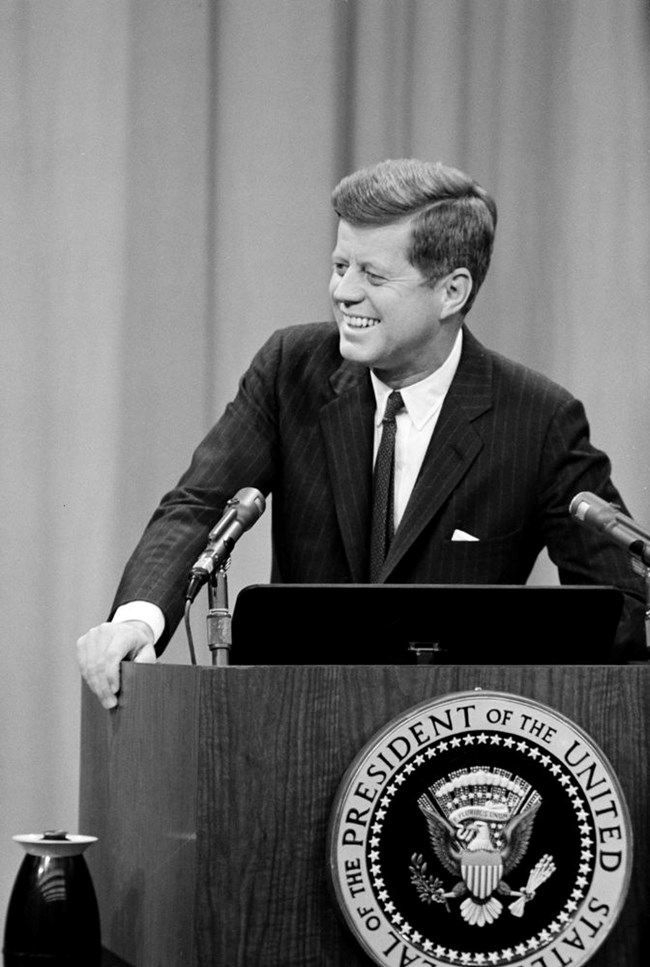
Cecil Stoughton. White House Photographs. John F. Kennedy Presidential Library and Museum, Boston, MA. ST-42-5-62
Introduction
John Fitzgerald Kennedy was born on May 29, 1917 in Brookline, Massachusetts. His parents, Joseph Patrick and Rose Fitzgerald Kennedy, had high expectations for all their children and instilled in young John the importance of public service. During his ten years in Brookline, John developed a strong sense of self and character that he would carry with him to the White House.
After one of the closest elections in U.S. history, John F. Kennedy was sworn in as the 35th President of the United States on January 20, 1961. Kennedy’s administration came at an especially turbulent time for the country. Relations between the United States and the Soviet Union were tense. Polls showed that more than half of Americans thought war with the Soviet Union was inevitable.
Americans also faced difficult circumstances at home. African Americans were barred from public facilities, denied the right to vote, and subjected to racism and violence. Other people of color, those with disabilities, and those who identified as LGB, were also marginalized. Women also faced discrimination, especially in the workplace where work and pay disparities existed. Poverty and unemployment were widespread. The new president had many pressing issues to face.
John F. Kennedy offered the country hope and the vision for change. Despite facing many challenges, Kennedy accomplished much in his three years as president. Though his time in office was tragically cut short, his ideas and values still resonate today, inspiring new generations in the 21st century.
"Today our concern must be with that future. For the world is changing. The old era is ending. The old ways will not do."
-Senator John F. Kennedy, "Acceptance of Democratic Nomination for President," July 15, 1960
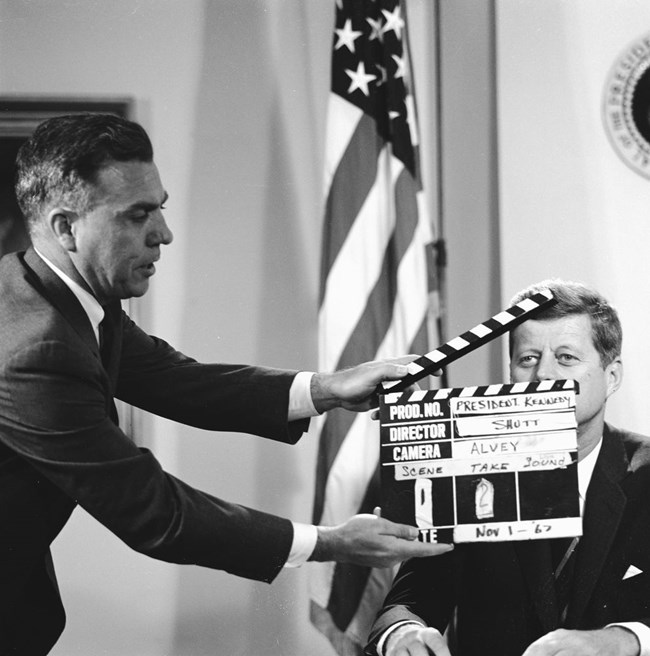
Cecil Stoughton. White House Photographs. John F. Kennedy Presidential Library and Museum, Boston, MA. ST-476-4-62
New Generation
Witty, charismatic, and handsome, John Kennedy’s youthful vigor attracted a new generation of Americans to public service and political engagement. At 43 years of age, Kennedy became the nation's youngest-elected president. In his nomination acceptance at the Democratic National Convention, he spoke of a “New Frontier-- the frontier of the 1960s, the frontier of unknown opportunities and perils, the frontier of unfilled hopes and unfilled threats.”
Mastering the new medium of television, JFK attracted young voters with his energy and optimism, and they campaigned tirelessly for him around the country. After the election, he encouraged them to turn “their interest into action” and enter public service. Many improved their communities at home while others spread American ideals abroad by serving in the Peace Corps.
The Peace Corps started as a modest proposal on the campaign trail that gained enthusiastic support. Kennedy promoted it as the “genuine effort by the people of the United States, particularly those who are young, to play their part in working for peace and improving the lives of all of mankind.”
After Kennedy’s death, young people continued to carry out his vision of peace and service. Thurgood Marshall Jr., Sergei Khrushchev, Senator Orrin Hatch, President Jimmy Carter, and Speaker of the House Nancy Pelosi were among those inspired by President Kennedy who worked to carry his legacy into the 21st century.
“Our problems are manmade--therefore, they can be solved by man.”
– President Kennedy, “Commencement Address at American University,” June 10, 1963
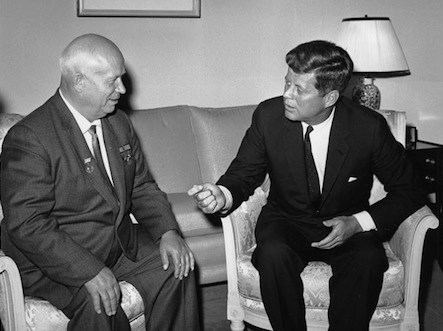
Photograph from the US Department of State in the John F. Kennedy Presidential Library and Museum, Boston, MA. PX 96-33:12
Foreign Policy
After WWII, the United States and the Soviet Union emerged as the two world superpowers. Allies during the war, their relationship soon turned hostile. An intense period of economic, military, and political competition began in what became known as the Cold War. Stockpiles of nuclear weapons grew, nations took sides, and the world became a very dangerous place.
Before John F. Kennedy became president, many Americans feared that communism would spread and believed that the United States was losing the nuclear arms race. In 1961, Soviets built the Berlin Wall physically dividing West and East Germany. The wall served as a symbolic reminder of the growing division between democracy in the west and communism in the east. Kennedy knew that in order to win over citizens at home and abroad, his administration would need to take action.
Kennedy balanced the difficulty of keeping America strong while avoiding actions that could lead the world into war. During his time in office, he: created the Peace Corps, signed The Limited Nuclear Test Ban Treaty, established the elite Navy SEALs, gave impassioned speeches about the importance of unity and co-existence, and helped stabilize unrest in Laos. Kennedy also monitored increasing tensions between North and South Vietnam and sent additional advisors to the region.
John F. Kennedy was one of a long line of Cold War presidents, but it was during his administration that tensions with the Soviet Union reached their highest peak. During the Cuban Missile Crisis of 1962, thermonuclear war was all but narrowly avoided. Had cooler heads like Kennedy’s not prevailed, our world might look very different today.
“We are confronted primarily with a moral issue...The heart of the question is whether all Americans are to be afforded equal rights & equal opportunities, whether we are going to treat our fellow Americans as we want to be treated.”
– President Kennedy, “Report to the American People on Civil Rights,” June 11, 1963
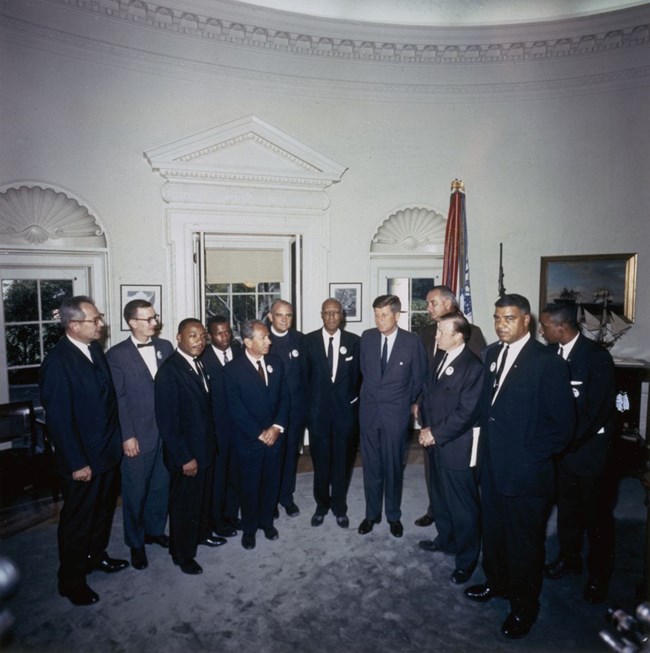
Credit: Cecil Stoughton. White House Photographs. John F. Kennedy Presidential Library and Museum, Boston, MA. ST-C277-1-63.
Civil Rights
In the years between the passage of the Fifteenth Amendment in 1870 and John F. Kennedy's inauguration in 1961, the federal government took little action to correct racial disparities within the United States. In the early 1960s, African Americans still faced harsh inequalities. Racial discrimination resulted in limited access to education, employment, healthcare, and housing. Protection from violence was not guaranteed, and intimidation at voting stations kept many from having their voices heard.
During the Kennedy presidency, the Civil Rights Movement gained attention as the actions of peaceful activists stirred violent reactions. Kennedy was reluctant for the federal government to become involved but as images of burning buses, police brutality, and other hate crimes filled the American media, Kennedy grew to understand the need for federal action. He ordered National Guard troops to protect African American students denied entry at the University of Alabama. Later that day, he addressed Americans in a televised speech, encouraging racial harmony, equality, and respect for law and order.
Women also faced widespread discrimination. In response, Kennedy created the President’s Commission on the Status of Women to work on behalf of women’s rights and to heighten awareness of economic disparity between the sexes. The commission made recommendations for the improvement of employment policies, tax and labor laws, and even provided necessary family services. President Kennedy also signed the Equal Pay Act in 1963. It was the first enacted legislation that attempted to create equality between work, pay, and sex.
President Kennedy's sister, Rosemary, was born with intellectual disabilities. To help her, and others like her, Kennedy became the first president to sign major disability rights legislation. However, Rosemary inspired her entire family to action. With the creation of The Joseph P. Kennedy Jr. Foundation, Special Olympics, and Very Special Arts, helping those with disabilities became one of the Kennedy family's greatest legacies.
"We choose to go to the moon in this decade and do the other things, not because they are easy, but because they are hard, because that goal will serve to organize and measure the best of our energies and skills, because that challenge is one that we are willing to accept, one we are unwilling to postpone, and one which we intend to win, and the others, too."
-President Kennedy, "Address at Rice University on the Nation's Space Effort," September 12, 1962
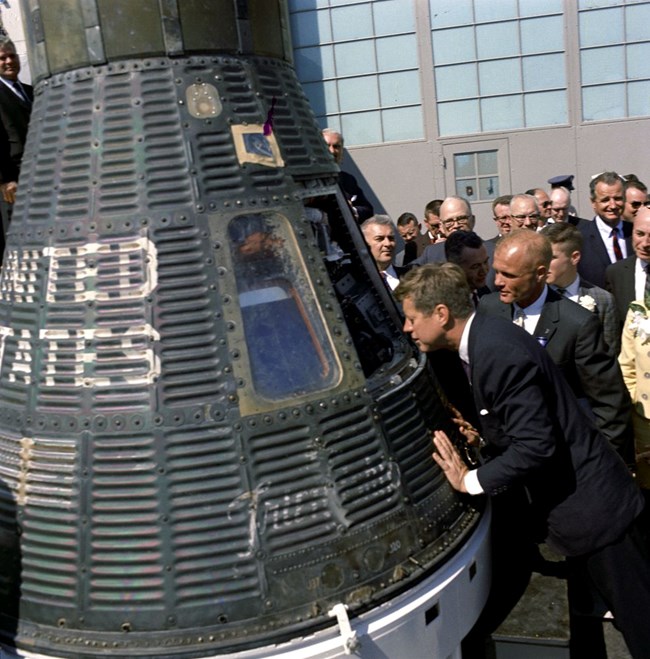
Cecil Stoughton. White House Photographs. John F. Kennedy Presidential Library and Museum, Boston, MA. ST-A13-60-62
Space Race
In April of 1961, the Soviet Union became first to launch a man into space. This event alarmed Americans and President Kennedy urged Congress to increase funding for space exploration. Among a variety of projects he envisioned, he asserted that, “This nation should commit itself to achieving the goal, before the decade is out, of landing a man on the moon and returning him safely to the earth.”
Kennedy’s request was both visionary and bold. The National Aeronautics and Space Administration (NASA) first had to discover if long-term space flight was possible. After several years of experimental development, untested astrophysics, and billions of dollars, Kennedy’s dream was realized in 1969 and the United States landed the first humans on the moon.
"A nation reveals itself not only by the men it produces but also by the men it honors, the men it remembers."
- President Kennedy, "Remarks at Amherst College on the Arts," October 26, 1963
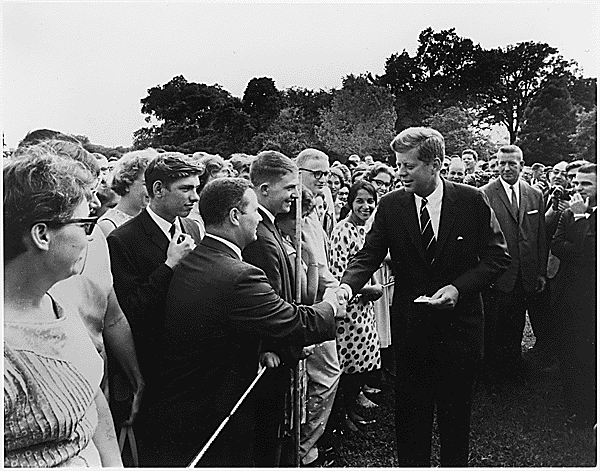
Photo by Abbie Rowe, Courtesy of National Archives, ID# 194180
Legacy
John F. Kennedy was in office for just over 1000 days. He was assassinated on November 22, 1963 in Dallas, Texas, while beginning his 1964 re-election campaign. As the world mourned, politicians and citizens joined together to finish the work Kennedy started. Shock and grief drove efforts to memorialize him, and today Kennedy buildings, institutions, schools, streets, and parks are found across the world.
More than 100 years after his birth, John F. Kennedy still matters. His vision of progress, service, and innovation continues to resonate in this new century and encourages us to dream of new possibilities.
Service
Americans across the country answered Kennedy’s call to service at home and abroad. Since its creation in 1961, the Peace Corps has engaged more than 235,000 volunteers who have served in 141 countries.
Exploration
John F. Kennedy’s lunar challenge became a crusade for NASA and future generations of Americans. Today, NASA is focusing on the exploration of Mars. The agency seeks to discover whether life exists on the planet and to provide a "continuous flow of scientific information and discovery."
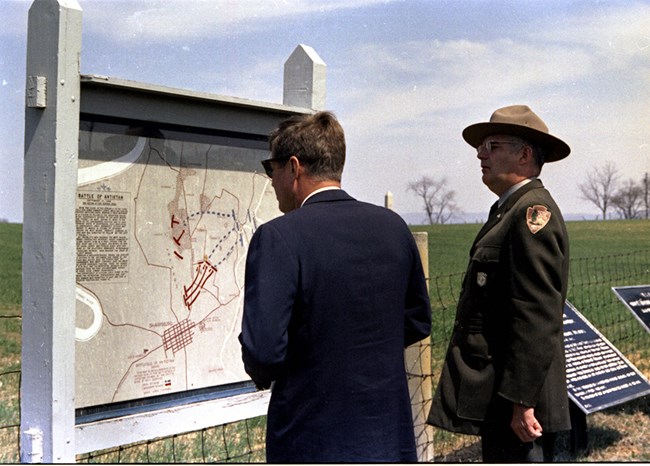
Robert Knudsen, Public Domain.
Equality
President Kennedy crafted the Civil Rights Act, which became law under the Johnson Administration in 1964. This act protected African Americans from voter discrimination and outlawed discrimination in hotels, restaurants, and other places of business. President Kennedy's brothers, Robert and Ted, carried on the same principles for which he stood. In their own roles as public servants, successive generations of Kennedys continue the work to help America’s most underprivileged citizens. While progress has been made, the struggle for human rights and equality continues.
Conservation
President Kennedy said “it is our task in our time and in our generation to hand down undiminished to those who come after us...the natural wealth and beauty which is ours.” He made an eleven-state conservation tour in the American west in 1963 and signed legislation for sixteen national parks units. Sometimes overlooked, conservation was one of his longest lasting legacies.
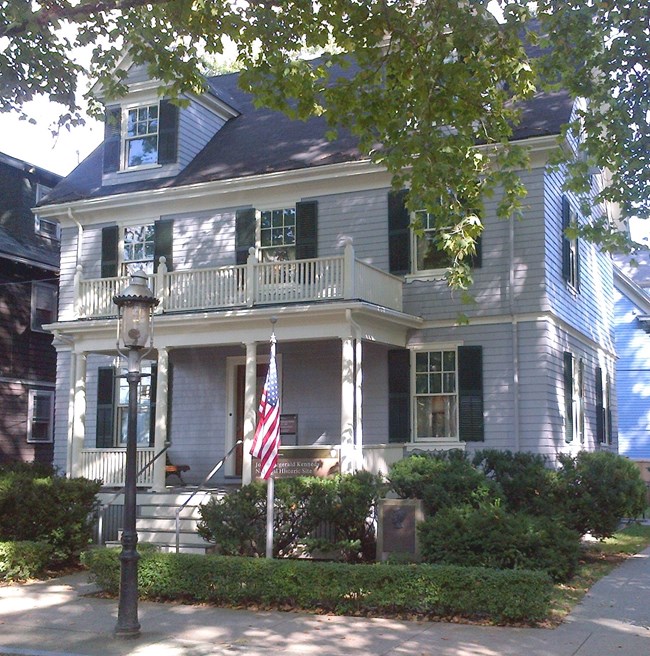
NPS
John Fitzgerald Kennedy National Historic Site
Efforts to memorialize President Kennedy’s birthplace increased after his death. After repurchasing the home at 83 Beals Street, close to fifty years after living there, his mother Rose Kennedy decided to return it to how it would have looked on the day her son was born. She donated the home to the National Park Service for visitors to “see how people lived in 1917 and thus get a better appreciation of the history of this wonderful country.” The birthplace became a unit of the National Park Service in 1967 and opened to the public on May 29, 1969.

NPS/Matt Teuten
Tags
- john fitzgerald kennedy national historic site
- kennedy family
- john f. kennedy
- john f. kennedy birthplace
- john f. kennedy national historic site
- presidency
- president
- president kennedy
- irish american history
- irish-american heritage
- irish-american heritage month
- president of the united states
- presidential leadership
- presidential history
- presidential birthplaces
- world war ii veterans
- irish
